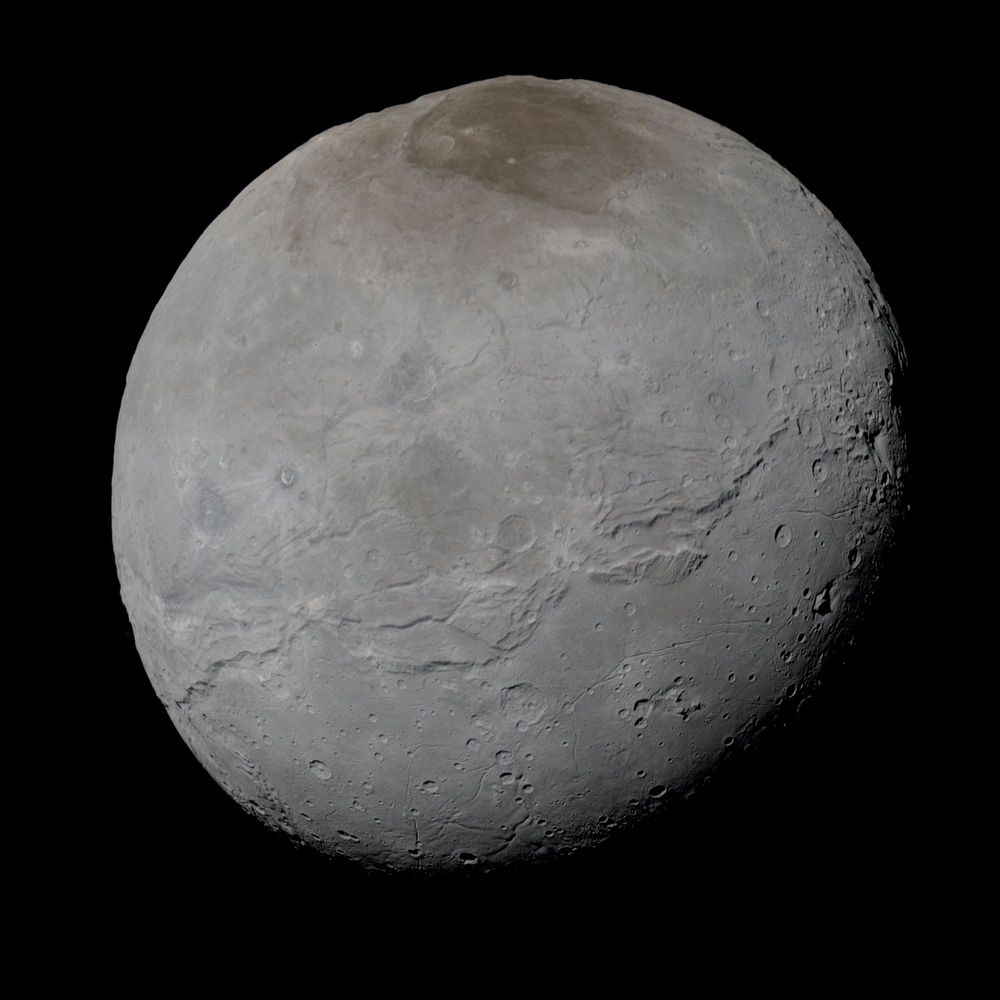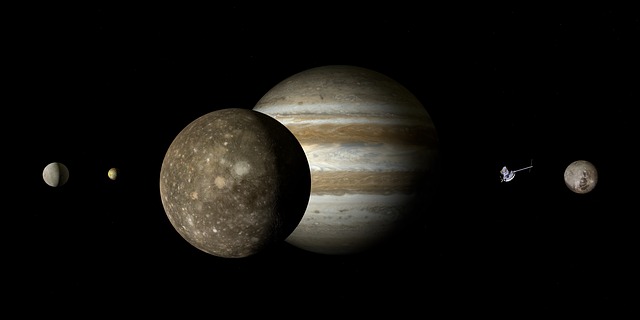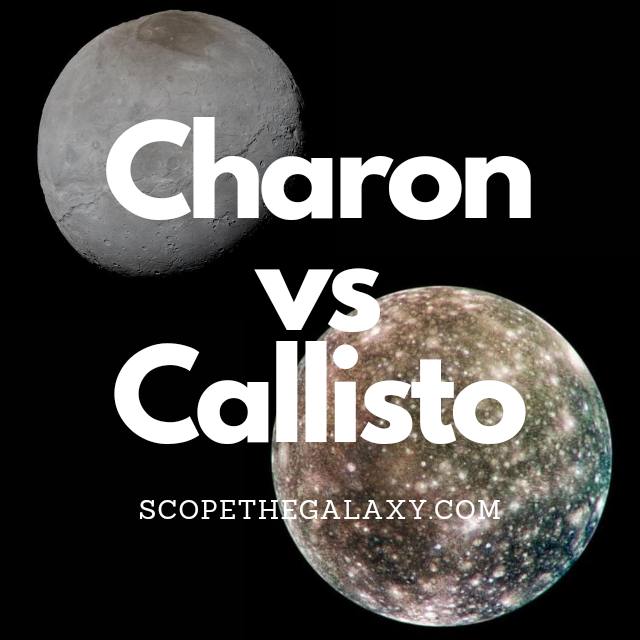*This post may contain affiliate links. This means we may make a commission if you purchase an item using one of our links*
Charon and Callisto are two of the moons located in the Milky Way solar system. The former is an icy world tidally locked to its almost sister planet, Pluto. Callisto is a giant, frigid landscape orbiting Jupiter. Both of these moons fascinate scientists as there’s a chance they could have water below the surface, meaning there is a potential for life.
Continue reading to learn about these fascinating moons, plus the similarities and differences between the two. Find out each unique physical feature and why these frigid worlds could hold the key to extraterrestrial life.
What Is The Moon Charon?
Table of Contents

Charon is the largest of Pluto’s moons, first discovered on 22nd June 1978. The surface of this icy world is frozen with nitrogen and methane ice; it may also hold some water ice. While Pluto possesses a reddish hue, Charon is closer to a neutral shade of grey; this suggests the two bodies have different compositions.
Scientists named this moon after the mythical ferryman, Charon, who once carried souls across the Acheron river. This river is one of five legendary rivers that could lie beneath the surface of Pluto.
The formation of Charon remains something of a mystery to scientists. However, this moon may have formed around 4.5 billion years ago when an object traveling at immense speed collided with Pluto. Its average distance from the Sun is approximately 3.6 billion km.
With Charon almost half the size of its planet, Pluto, scientists refer to these two bodies as a “double dwarf planet system,” and the chilly temperatures vary from minus 23 to minus 258 degrees Celsius.
Charon takes 153 hours to orbit its planet at an average distance of 19,640km, and it is tidally locked, meaning the same side of the moon always faces Pluto. Pluto also experiences a tidal lock to Charon, so the same two sides always face one another.
Among the fascinating features of this ice moon are the ice volcanoes that could exist on the surface. Observations from the Gemini observatory suggest that Charon could have a form of cryovolcanism known as ice-particle geysers. The frigid world also has a canyon between seven and nine kilometers deep. (To put that into perspective, Mount Everest has a height of 8.8km).
What Is The Moon Callisto?

Callisto is one of the large moons orbiting Jupiter, the outermost of the Galilean moons, first discovered on 7th January 1610. The surface of this icy world is frozen, but scientists believe an underground ocean could reside beneath the ice.
Even if there’s water on Callisto, it won’t necessarily hold life because the surface is so old. Scientists will need to conduct more research into the moon before determining whether this is a likely possibility.
The ESA’s JUICE (Jupiter Icy Moon Explorer) mission is focused on the three ice moons of Jupiter. It is expected to arrive in 2030 and will focus on learning more about the environment of each, as well as their potential for hosting life.
Scientists estimate that Callisto is around 4.5 billion years old (the same age as Jupiter), and its average distance from the Sun is approximately 778 million km. It has a diameter of 4820.6km, which makes it similar in size to the planet Mercury, and the average temperature is a frigid minus 139.2 degrees Celsius.
Callisto takes seven days to orbit its planet at an average distance of 1,880,000km, and it is tidally locked, meaning the same side of it always faces Jupiter. But this moon experiences less tidal influence than the other Galilean moons because it lies in the orbit of Jupiter’s primary radiation belt.
The name of this moon is derived from the stories of Greek myth. Callisto was the nymph who had an affair with Zeus, the King of the Gods. Upon hearing this news, Zeus’ wife Hera turned Callisto into a star and placed her in the Ursa Major constellation. Interestingly, every moon of Jupiter is named after a Greek figure who Zeus seduced.
Callisto may be the third biggest moon and similar in size to the planet Mercury, but it only has a mass of 107,593,737,963.819 billion kg. That may sound like a lot, but it’s only ⅓ the mass of the similarly sized Mercury.
You may wonder why scientists classify Callisto as a “moon” rather than a planet if it’s almost the same size as Mercury. The reason is simple; planets must orbit the sun, but Callisto orbits one of the planets.
The composition of this frigid world is around 60% rock and iron and 40% ice. The moon has roughly equal amounts of rock and ice, plus the potential for water below the surface. There are also traces of carbon dioxide, organic compounds, and silicates.
This moon is one of the oldest landscapes in the Milky way and the most heavily cratered body in our system. However, scientists believe this could now be a “dead” moon as there are no longer any signs of volcanism or plate tectonics on its surface.
Similarities Between Charon And Callisto
Some of the similarities that Charon and Callisto share include the following:
- Both Charon and Callisto are ice worlds.
- There could be water beneath their icy surfaces.
- They are both similarly sized to other planets in the solar system: Charon is a similar size to Pluto, and Callisto is a similar size to Mercury.
- Both moons are named after mythical beings.
- Scientists still have a number of questions about these frigid worlds that they intend to answer through space probe missions.
Differences Between Charon And Callisto.
In regards to the differences, they I include the below:
- Charon is one of Pluto’s moons, and Callisto is one of Jupiter’s moons.
- Callisto is far larger than Charon – the former is the third biggest moon in our solar system.
- Callisto is commonly considered a dead planet because it no longer displays any surface activity.
- Charon may be home to ice mountains and deep canyons.
- Charon is millions of miles further from the Sun than Callisto is; the temperature here drops to almost absolute freezing point. (Callisto is a “mild” minus 139 degrees Celsius in comparison)
- Callisto was discovered three centuries before Charon.
Summary
Charon is the faraway ice world, where temperatures drop close to absolute zero, and mountains and canyons sculpt the landscape. Callisto is one of the giant Galilean moons locked in an orbit with Jupiter, with the most cratered surface in our solar system.
Both continue to fascinate astronomers for their potential to hold life. Only epic adventures by space probes will be able to provide the answers to these questions.
References
https://solarsystem.nasa.gov/moons/pluto-moons/charon/in-depth/#:~:text=At half the size of,phenomenon called mutual tidal locking.
https://www.space.com/16448-callisto-facts-about-jupiters-dead-moon.html

